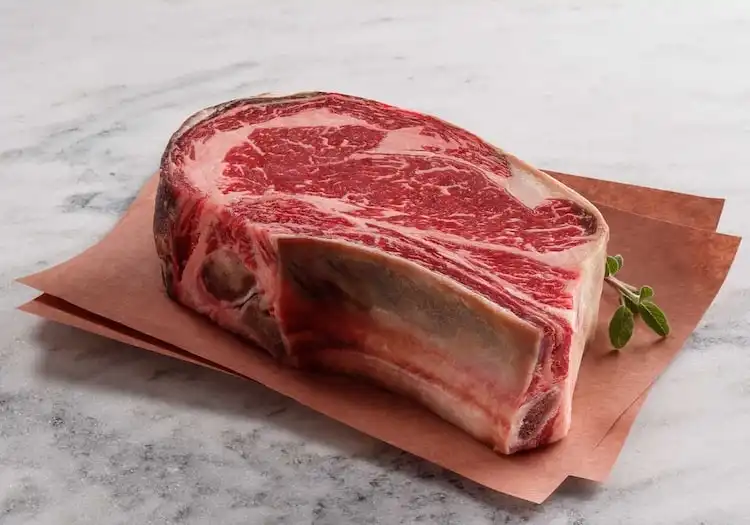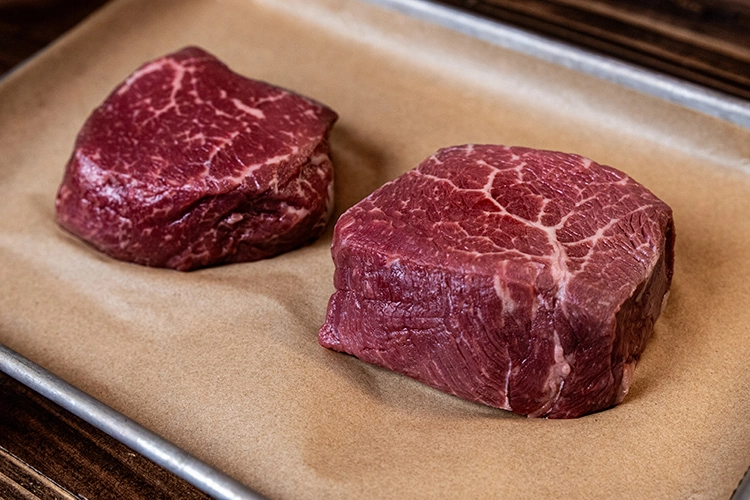Dry-Aging vs Wet-Aging: What’s the Difference?

If you want to get the best steak for your dollar, it helps to understand what actually matters, and what is marketing jibberish.
If you’re in the market for high-end steak you’ll be blasted with the phrase “dry-aged” but what does it actually mean, and what are the real differences between dry-aging and wet-aging? Let’s find out.
What is the difference between dry aging and wet aging beef?
Dry-aging beef is a time-honored process where animal carcasses or primal cuts are hung up and exposed to the air at a cold temperature. This process can last for weeks or even months.
Wet-aging, on the other hand, is when beef is packed, vacuum-sealed, and refrigerated soon after slaughter. This aging process usually occurs in transit, from where the meat is packed to its delivery to your supermarket shelf.
What’s the purpose of aging meat?
The main purpose of aging meat is to make it more tender, resulting in a more palatable texture that breaks down easier in your mouth.
During the process of aging meat, the muscle fibers and connective tissues are broken down, creating shorter fibers that are easier to chew.

All meat benefits from being aged in some capacity before consumption.
- Once the animal is slaughtered, the muscle fibers stiffen as rigor mortis sets in.
- In cattle, this can last for around six to twelve hours.
- Refrigerating the carcass helps to reduce this stiffening; however, the meat still will need to be aged to increase its tenderness.
Whether your meat is wet or dry-aged, enzymes that are naturally present will begin to break down the connective tissues.
This process can take anywhere between several days to weeks. Depending on whether your meat is dry-aged or wet-aged, the process, results and taste will vary considerably.
Let’s take a closer look at the differences between each method.
What is dry-aging?
To dry age beef, whole sides or primal cuts are hung and left to age. The process is carried out at temperatures just above freezing and can take several weeks or even months.
Exposing meat to air in this carefully controlled environment allows microbes and the muscle’s enzymes to break down the protein and fat into fatty acids, amino acids, and sugars.
In the same way that cheese is fermented, this process increases flavor and alters the meat’s texture.
Dry aging causes meat to lose some of its moisture content, typically reducing levels from around 75% to 70% moisture. This gives dry-aged meat its “beefier”, richer flavor.
The longer the meat is dry-aged the more tender it will be, with a stronger flavor. However, dry-aging meat also reduces its volume. As the surface of dry-aged carcasses needs to be trimmed, removing the exposed outer layer, the yield is further reduced.
This reduction in meat yield from the dry-aging process, plus the time and space that is needed to process it, results in a higher price per pound than wet-dried meat.
The longer meat is aged, the greater the weight lost.

The often touted superior flavor of dry-aged meat also attracts a more discerning clientele, who are more likely to pay top dollar for an air-dried premium cut.
As dry-aging is a more laborious and costly process than wet-aging, dry-aged meat is increasingly becoming a specialty food, although meat has been traditionally dry-aged by humans since time immemorial.
In fact, it’s even possible to dry-age beef at home using some basic equipment, for instance, dry-aging bags.
What is wet-aging?
Unlike dry-aging, wet-aging meat is a fairly recent technique that has become extremely popular.
It allows beef producers to increase their profits as the meat is aged in transit, rather than requiring a dedicated aging chamber. Shortly after slaughter, meat is cut and portioned, then vacuum sealed in plastic.
This air-tight Cryovac packaging allows the meat to tenderize, as the enzymes naturally present in the muscle continue to break down connective tissue and fibers. However, as there is no moisture loss nor bacterial spoilage, yields are high and prices per pound are generally much lower.
Much like the difference between pasteurized cheese and fermented cheese, the flavor of a dry-aged or wet-aged steak can be very different.
However, even dry-aged meat connaisseurs agree, certain leaner and thinner cuts greatly benefit from wet-aging. This prevents them from drying out – a common occurrence with dry-aged cuts lacking in protective bone and fat.
Dry-aging vs wet-aging: which is better?
This brings us to the big question: which is better; dry-aged or wet-aged meat? In short, it all depends on your personal taste, the cut of meat, and your budget.
Quality
OK, let’s recap. Dry-aging meat is a more expensive process than wet-aging. It takes time, space, and supervision. It also produces lower yields than wet-aging.
For this reason, many meat producers have switched to wet-aging and now use the transit time from butchering to the store to allow for aging to take place.This means that nowadays, most dry-aged meat is of prime quality from specialty producers.
So, regardless of the aging process itself, dry-aged meat is often of a superior quality to start with. Something worth bearing in mind.
Flavor
With regard to flavor, it all comes down to personal preference.
Many people prefer the “meatier” flavor of dry-aged steak. However, meat that has been dry-aged for a considerable length of time isn’t to everyone’s taste.
On the other hand, wet-aged meat may have more intense, sour notes, compared to a dry-aged cut. This is because the vacuum sealing process doesn’t allow the meat to breathe.
Moisture
What’s more, flavor aside, due to the moisture loss that occurs during the dry-aging process, not all cuts of meat are suited to dry-aging.
Flat iron, chuck tenders, and skirt are just some types of beef cuts that tend to dry out too much when dry-aged. In fact, any low-fat, lean cuts, such as filet mignon, can benefit from wet-aging.
Cuts that benefit most from dry-aging are large muscle and subprimal cuts on the bone, as layers of fat and bones prevent them from over-drying.
Sirloin and ribeye steaks are good examples of cuts that are greatly improved in both flavor and texture when dry-aged.
Ultimately, it comes down to what cut you’re cooking and your personal preferences, availability, and budget. We think everyone should try a premium dry-aged steak at least once. However, for your average weeknight supper, there’s nothing wrong with a wet-aged version.
Many people prefer wet-aged steaks, and given that supermarkets tend to stock huge quantities of wet-aged meat at low prices, it’s an extremely popular choice. Yet, like fine wines, small-batch bourbons, and artisan cheeses, there will always be a market for the traditional dry-aged steak.
Wrapping it up
Wet-aged beef is moister, cheaper, and more readily available. It is also preferable for lean cuts that dry out too much when dry-aged.
On the other hand, while dry-aging meat produces lower yields and comes with a higher price tag, it can enhance flavor and texture. If you’re after a meatier tasting sirloin, for example, then dry-aging is the way to go.
What do you think? Do you have a favorite? Drop us a line below in the comments section, we’d love to hear from you!








